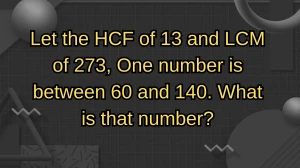Which Set of Angles has the same Trigonometric Ratio?
by
Updated Jun 17, 2024

Which Set of Angles has the same Trigonometric Ratio?
The given problem is to find which set of angles has the same trigonometric ratio.
- sin 45 and tan 45
- sin 30 and cos 60
- cos 30 and tan 45
- tan 60 and sin 45
Trigonometric ratios are functions of an angle used in various calculations involving right-angled triangles. The main trigonometric ratios are sine (sin), cosine (cos), and tangent (tan). These ratios have specific values for particular angles.
Key Trigonometric Ratios
sin(θ) = opposite/hypotenuse
cos(θ) = adjacent/hypotenuse
tan(θ) = opposite/adjacent
Specific Angle Values
sin 45° = √2/2
tan 45° = 1
sin 30° = 1/2
cos 30° = √3/2
tan 30° = 1/√3
cos 60° = 1/2
tan 60° = √3
In the given the sets of angles
sin 30° = 1/2 and cos 60° = 1/2
These values are equal.
Among the given options, the set of angles that has the same trigonometric ratio is
sin 30° and cos 60°
Trigonometric Ratios and Properties
Trigonometric ratios are fundamental concepts in trigonometry, a branch of mathematics that deals with the relationships between the angles and sides of triangles. These ratios are especially important in right-angled triangles.
Trigonometric Ratios
Sine (sin):
The sine of an angle in a right-angled triangle is the ratio of the length of the opposite side to the hypotenuse.
sin(θ) = opposite/hypotenuse
Cosine (cos):
The cosine of an angle is the ratio of the length of the adjacent side to the hypotenuse.
cos(θ) = adjacent/hypotenuse
Tangent (tan):
The tangent of an angle is the ratio of the length of the opposite side to the adjacent side.
tan(θ) = opposite/adjacent
Applications
- Trigonometric ratios are used in various fields such as physics, engineering, and astronomy.
- They help in calculating distances and angles in navigation and surveying.
- In architecture and construction, trigonometric ratios assist in designing structures and ensuring stability.
- Trigonometric ratios and their properties are essential for solving problems involving right-angled triangles. These ratios provide a foundation for more advanced studies in mathematics and science.




